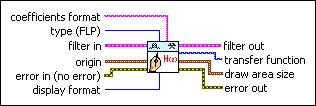DFD Render Transfer Function Equation VI
Owning Palette: Utilities VIs
Installed With: Digital Filter Design Toolkit
Draws the transfer function of a filter in a picture indicator.

 Place on the block diagram Place on the block diagram |  Find on the Functions palette Find on the Functions palette |
 | coefficients format specifies how this VI converts the filter coefficients into a string. | ||||||
 | type specifies the type of transfer function to draw.
| ||||||
 | filter in specifies the input filter. | ||||||
 | origin specifies the upper-left-hand position of the transfer function this VI draws.
| ||||||
 | error in describes error conditions that occur before this VI or function runs.
The default is no error. If an error occurred before this VI or function runs, the VI or function passes the error in value to error out. This VI or function runs normally only if no error occurred before this VI or function runs. If an error occurs while this VI or function runs, it runs normally and sets its own error status in error out. Use the Simple Error Handler or General Error Handler VIs to display the description of the error code. Use error in and error out to check errors and to specify execution order by wiring error out from one node to error in of the next node.
| ||||||
 | display format specifies the format in which this VI displays the transfer function.
| ||||||
 | filter out returns the filter in unchanged. | ||||||
 | transfer function returns the transfer function of filter in in a picture indicator. | ||||||
 | draw area size returns the size of the area in the picture indicator this VI uses to draw the transfer function.
| ||||||
 | error out contains error information. If error in indicates that an error occurred before this VI or function ran, error out contains the same error information. Otherwise, it describes the error status that this VI or function produces.
Right-click the error out front panel indicator and select Explain Error from the shortcut menu for more information about the error.
|
Example
Refer to the Filter Rendering VI in the labview\examples\Digital Filter Design\Getting Started\Analyze Filters directory for an example of using the DFD Render Transfer Function Equation VI.






